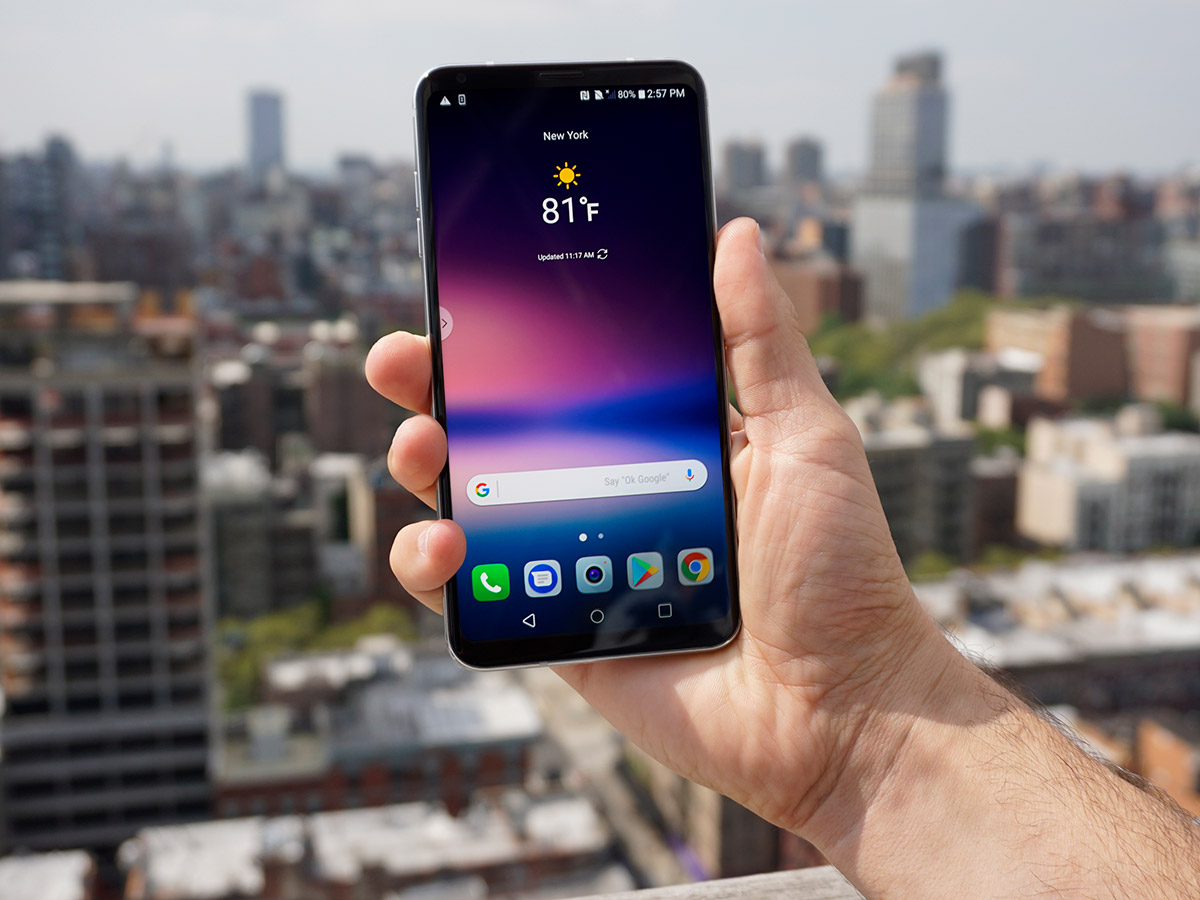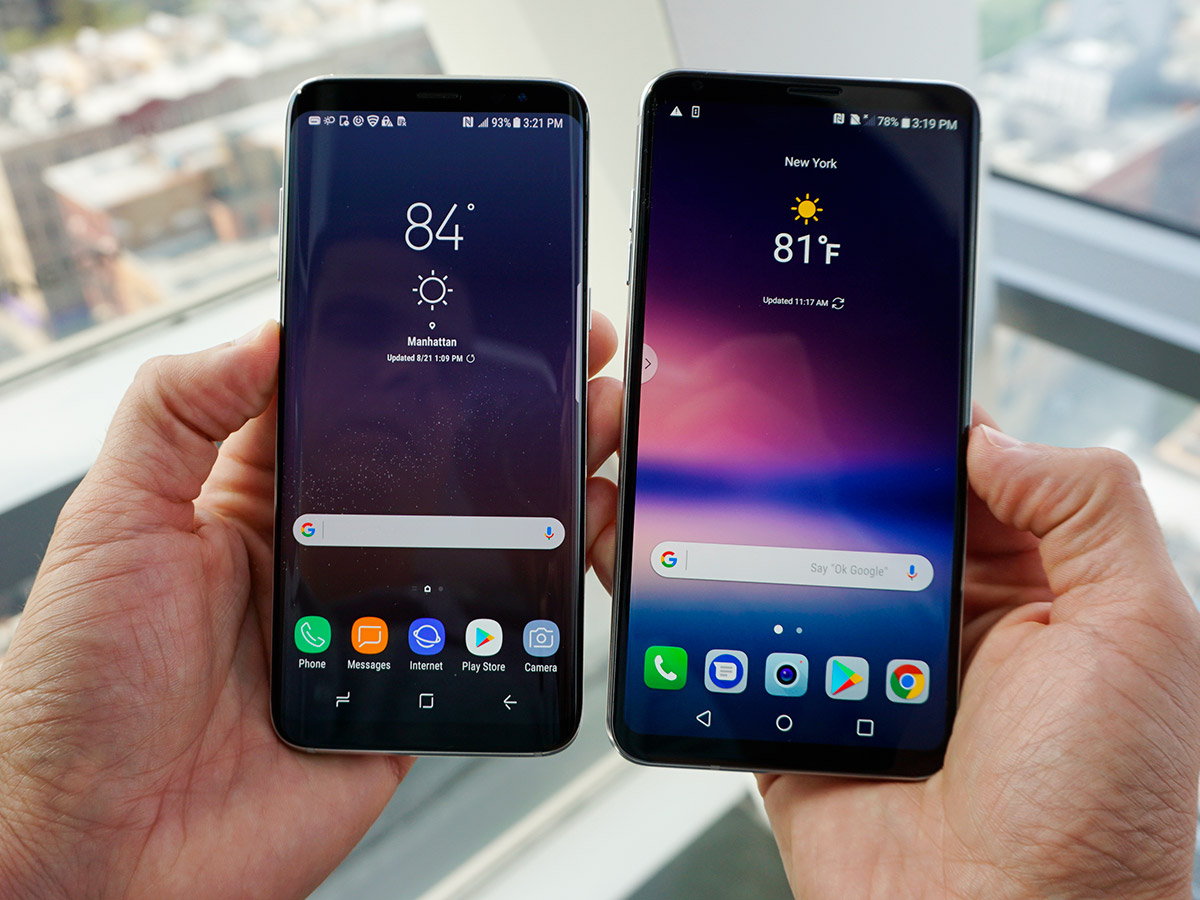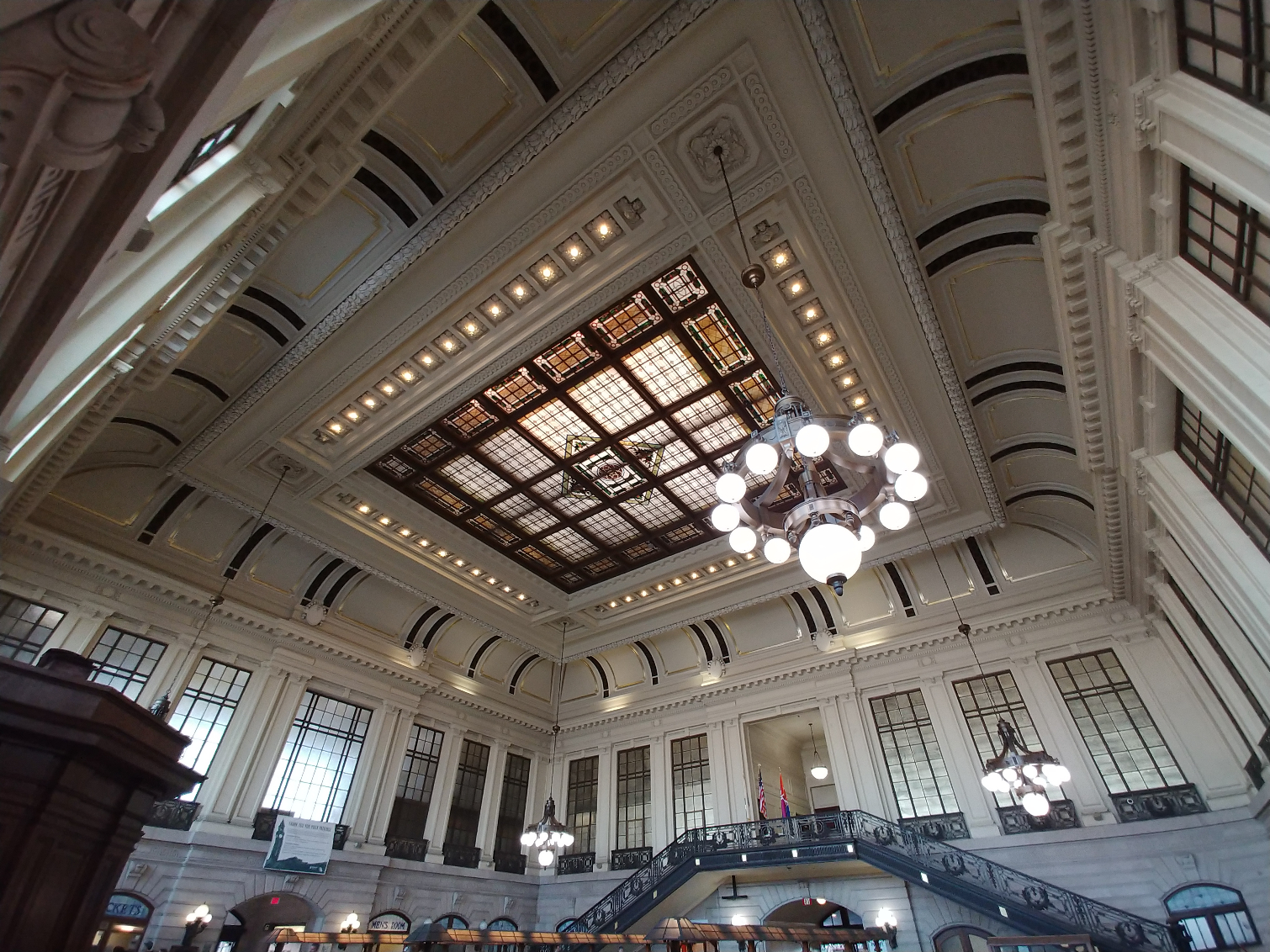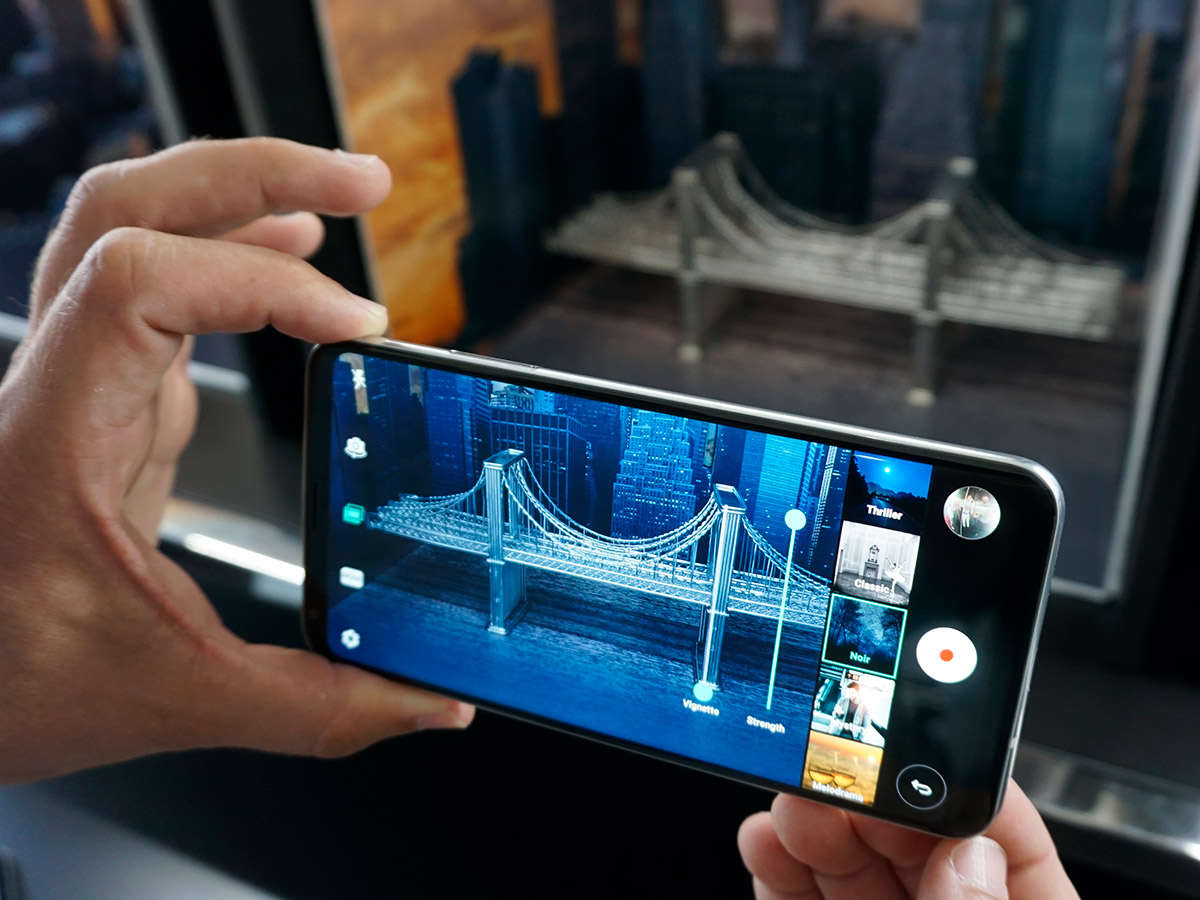LG V30 Hands-on: Glorious Screen Meets Mighty Dual Cameras
Can the LG V30's 6-inch OLED screen and dual cameras take on the likes of Apple and Samsung? We go hands-on with LG's new flagship phablet.
LG may have beat both Apple and Samsung as the first company to launch a phone with two cameras on its back, but both phone makers have responded with the iPhone 7 Plus and the upcoming Galaxy Note 8.

So with its latest flagship, the V30 — available this fall on AT&T — LG is touting not just the phone’s dual cameras, but what you can do with them. This includes being able to add sorts of effects to your videos on the fly, including color profiles and a new Point Zoom feature.
In addition to its rear cameras, the V30 features a colorful 6-inch OLED display and a digital analog converter for better audio. LG sent us a pre-production unit of the V30, and after trying it out, we think the smartphone holds some promise.
Design
The V30 looks nice, but in an age of beveled edges and Infinity Displays, LG's new phone doesn't distinguish itself. Its polished metal sides are broken up intermittently by small vertical stripes.

There’s no power button on the edge, as one might expect. Rather, the fingerprint reader on the shiny silver back pulls double-duty. As someone accustomed to a power button on the side, this definitely was an adjustment; I kept unconsciously pressing the volume buttons on the left side in vain.

It’s a fine design, and I like that LG has minimized the V30’s bezels as much as it did, but the phone lacks the flair of the Galaxy S8’s bezel-free Infinity display. I also found the width of the V30 (2.96 inches) made it harder for me to reach my thumb all the way across the screen, as I could easily do with the S8’s 2.7-inch-wide body. The V30 and the S8 weigh about the same: 5.6 and 5.5 ounces, respectively.
MORE: Best Camera Phones
Thankfully, making your flagship phone water-resistant has become table stakes. As with its main competitors, the V30 can be submerged in up to 1.5 meters of water for up to 30 minutes.
| Row 0 - Cell 0 | LG V30 | Samsung Galaxy S8 | Samsung Galaxy Note 8 | iPhone 7 Plus |
| Display | 6-inch OLED Quad HD+ (2880 x 1440) | 5.8-inches (2960 x 1440) Super AMOLED | 6.3 inches (2960 x 1440) Super AMOLED | 5.5-inch (1920 x 1080) Retina HD |
| Camera (back) | Wide-angle: 16MP (f/1.6)Telephoto: 13MP (f/1.9) | 12 MP (f /1.7) | 12MP/12MP | Wide-angle: 12MP (f/1.8)Telephoto: 12MP (f/2.8) |
| Camera (front) | 5MP | 8 MP, f/ 1.7 | 8MP | 7MP, f/2.2 |
| Processor | Snapdragon 835 | Snapdragon 835 | Snapdragon 835 | A10 Fusion |
| RAM | 4GB | 4GB | 6GB | 3GB |
| Storage | 64GB | 64GB | 64GB | 32/128/256GB |
| microSD | 128GB | 256GB | 256GB | none |
| Battery | 3,300 mAh | 3,000 mAh | 3,300 mAh | 2,900 mAh |
| Weight | 5.6 ounces | 5.5 ounces | 6.8 ounces | 6.6 ounces |
| Water Resistance | IP68 | IP68 | IP68 | IP67 |
Display
The OLED display on the V30 is stunning. I was treated to deep blacks in the graveyard scene in Taylor Swift’s Look What You Made Me Do video, and the bathtub full of jewels sparkled. Her red lipstick and dress really popped, too. The contrast was equally excellent in The Jast Jedi trailer, too.
When playing the trailer side by side with the Galaxy S8, colors on the V30 were much more true to life. On the S8, Rey’s hand had a reddish hue, for example. I also noticed much better contrast and crisper details.
At 6 inches even, the V30’s display splits the difference between the Galaxy S8 (5.8 inches) and the S8+ (6.2 inches), but has a lower resolution of 2880 x 1440, compared to 2960 x 1440 for the Samsung devices.
Camera
Like the Samsung Note 8 and the iPhone 7 Plus, the V30 has two cameras, but the LG cameras’ functions are somewhat more limited than on its competitors. Unlike the Note 8 and the iPhone 7 Plus, you can’t use the V30’s two cameras simultaneously to achieve a bokeh effect; that is, you can’t selectively blur the background for things like portraits.
The main function of the V30’s dual cameras is to enhance the quality of photos as you zoom in. The V30’s wide-angle camera has a resolution of 13MP, and a 120-degree field of view, while its telephoto lens has a 16MP resolution and a 71-degree FOV. That 16MP lens also has an f/1.6 aperture, which should let in more light.
The V30’s wide-angle lens let me capture much more of a scene than the Samsung Galaxy S8. For example, in a shot of the New York harbor taken from New Jersey, the S8’s field of view was only wide enough to get lower Manhattan, while the V30 was able to get higher uptown, into the 20s.

Indoors, the V30’s wide-angle lens was able to capture the entirety of this train station’s roof and walls.
We’re withholding our final judgment of the V30’s camera until we get our final production unit, but an early comparison with the S8 shows that the V30’s images aren’t as sharp. For example, the S8 was able to capture much greater detail of a sleeping dog than the V30; on the former, you can see individual hairs, while on the latter, it’s more blurry. While it looks like the V30's photo was taken from farther away, it wasn't; the V30's wider-angle lens merely made it appear so.
If you press and hold the V30's shutter button, you can slide it up and down to zoom in and out of a photo. This is a really clever feature, as it means you don’t have to take your thumb off the shutter in order to adjust the zoom.

Video Recording Fun
Ever wanted to make your own Hitchcock film, or maybe just a Rom-Com? A Cine Video mode in the V30 lets you apply one of 15 filters to your video to give it the appropriate tone.
Flashback, for instance, gives everything a sepia tone, while Noir and Thriller each add a blue cast. In each, you can select the degree to which the effect is applied, and add vignetting to the corners. It’s a fun addition, but the feature merely feels like a variation of the other eight filters you can already apply from the camera’s main screen. Also, if you’re in Cine Video mode, you can’t make manual adjustments to the white balance, exposure, ISO, etc.
Perhaps the only reason to use Cine Video is that it’s the only mode that lets you use Point Zoom. This feature lets you select an object on screen, and the camera will zoom into it, Ken Burns-style.
Interface: From Dual Screens to a Floating Bar
LG's previous flagship, the V20, had a second screen running along the top of the front, which let you quickly switch apps, accessing settings such as the flashlight, and more. The V30 lacks this second screen, but makes up for it — somewhat — with the Floating Bar. LG’s answer to Samsung’s side menu, the Floating Bar is a small menu that pops out from the side of the display, and gives you quick access to contacts, apps, or music controls. The bar can be re-positioned anywhere on the screen, but it’s far less useful than Samsung’s offering. You’re limited to just five shortcuts, for example.
When activated, a small translucent semicircle with a carat appears along the edge of the screen. Tap it, and the Floating Bar appears. If you try swiping the semicircle, it will cause the bar to relocate itself to the other side of the display. It’s not quite intuitive; I often swiped when I should have tapped.
Audio: Straining to Hear the Difference
LG is also appealing to audiophiles with a built-in Digital-Analog Converter (DAC), which purports to offer better music playback to connected headsets and speakers by converting the digital audio file to an analog one.

I tested it out by connecting a pair of FIIL IICON headphones to the V30 and later to a Samsung Galaxy S8, and playing several Michael Jackson songs from FLAC files on each phone.
Turning Hi-Fi Quad DAC on and off as Billie Jean played, the differences were subtle. I (and my colleague, Sherri Smith, our resident audiophile) detected slightly better definition overall, but we really had to listen for it. Similarly, when I played the same file on the S8, I had to concentrate to detect variations.
The Hi-Fi Quad Dac app on the V30 also lets you choose between several presets (Normal, enhanced, Detailed, Live, and Bass); switching between these alters equalizer settings. You can also adjust a digital filter to change sound characteristics, and adjust the balance between the left and right channels.
Video Editing: Basic

Quick Video Editor lets you select a bunch of videos and stills, and then it composites them into a video. Here, you can edit each clip, trimming its length, or applying a filter (called Themes), titles, soundtracks, and adjusting the audio. Annoyingly, you can’t apply the same Cine Video filters at this stage, which seems like a missed opportunity. You also can’t change the transitions between each of the clips, either, so it just jumps from one to the next.
Security: Three Levels

The LG V30 offers three levels of security: Voice Print, Face print, and Fingerprint. You can use your fingerprint to lock the phone, as well as lock content in the Gallery and QuickMemo+. Voice Print and Face Print let you unlock the phone using either your voice (and a "wake word" that you specify) or your face, respectively. These latter two security measures are located under the Lock Screen sub-menu in Display settings, while the Fingerprint reader is in the Privacy header in General settings.
LG warns that both Face Recognition and Voice Recognition can be spoofed by a similar face or a voice recording, and should not be considered primary means of locking your phone.
After setting up the V30 to unlock the phone using my face, it recognized and unlocked the phone instantaneously; it was as if I didn’t have a lock on it at all.
Outlook
The LG V30's OLED display and wide-angle camera were the two features of the phone that have impressed me the most so far. Will they be enough to turn consumers' attention away from the Note 8's S Pen and split-screen multitasking, or the iPhone 7 Plus—or iPhone 8? That seems to be a tall order.
That’s all we can share for now about the V30; we’re waiting to get a final production unit before running all of our tests and rendering our final verdict. Pricing has not yet been set, but the phone will be available on AT&T and T-Mobile later this fall.
Sign up to get the BEST of Tom's Guide direct to your inbox.
Get instant access to breaking news, the hottest reviews, great deals and helpful tips.

Michael A. Prospero is the U.S. Editor-in-Chief for Tom’s Guide. He oversees all evergreen content and oversees the Homes, Smart Home, and Fitness/Wearables categories for the site. In his spare time, he also tests out the latest drones, electric scooters, and smart home gadgets, such as video doorbells. Before his tenure at Tom's Guide, he was the Reviews Editor for Laptop Magazine, a reporter at Fast Company, the Times of Trenton, and, many eons back, an intern at George magazine. He received his undergraduate degree from Boston College, where he worked on the campus newspaper The Heights, and then attended the Columbia University school of Journalism. When he’s not testing out the latest running watch, electric scooter, or skiing or training for a marathon, he’s probably using the latest sous vide machine, smoker, or pizza oven, to the delight — or chagrin — of his family.
-
mooksmom.hj LG & AT&T both have such BAD customer service, I would NOT own one even if they were giving them away! I didn't see the PRICE anywhere. NOT paying $950 for a Samsung of any kind. Apple...I still won't own one and Steve Job's been dead for years.Reply
Guess I will keep my Galaxy Note 4 a few more years...and it still works just fine! -
nishadarora89 Note 8 looks like its worth it lets wait and watch.I will buy only if the price and feel is riteReply -
stlscott18 Android is wiping Apples behind with its phones / specs, but unfortunately, I still can't live without my blue imessage bubble. IOS is smooth and its end-to-end encryption for iMessage is what I want. I loved my S8+ while I had it, but I couldn't find a perfect messaging app (if the received doesn't use the same Snowden messaging app, then it's useless), people didn't understand why they couldn't facetime with me, and every time I got a video from somebody from an Iphone, the quality was terrible! However, the phone itself...wow. What a beauty. Samsung throws everything at you.Reply -
carlocaterer LG V30 Cameras shine in two key areas: larger field of view and more detailed backgrounds, but the foreground- the key area- belongs to other cameras by far.Reply
Switching gears- flagship designation(especially any model with +, Plus, XL, Max, Pro), TODAY, requires the following minimums: 6¼" display, QHD, 6gb Ram, 128gb storage, Quick Charge 4, NFC, SD slot.
WORLDWIDE that is, not just only Asia or a particular carrier.
That was the bare minimum, then brands that wish to stand out will increase and add other stuff as necessary.
And let me add that LG should NOT do away with removable batteries IF it wishes to keep standing out from the pack.
And now thru the end of 2017 will see more phone releases and announcements of such specs.
Otherwise tech news has acquired some of the same bad symptoms of news in general today:
we're all reading urgent news flashes of the latest brilliant phone to top all other competitors, with "large" 5.2-5.5" display, "generous" 3gb/32gb expandable to xx with SD, the battery is not removable but now has an extra 10 mhz capacity, etc. ..plus extra absurdities like "the camera has 1 more MP than so and so's, and the manufacturer firmware lets you access your apps from the lock screen, tag your pictures with inane gifs, the phones come in choice of hot fuchsia, neon aquamarine, etc.
Products best suited for preteens and Lilliputians, rather than adult entrepeneur types. -
kimersonp As for the V30 picture of the two dogs showing the Samsung being a better photo than the V30, try taking the EXACT SAME PHOTO for BOTH. You have a close-up image of the Samsung dog and a much farther distant photo of the V30 dog. Of course the Samsung is going to show individual hairs. Come on, Tom's Guide, you folks are much better than that to result to subterfuge. It is beneath you.Reply -
jtfrazier You indicated that the sound difference was really subtle. Did you use the FIIL IICON as wireless only? If so, they didn't go through the quad dac. (They did go through aptX Bluetooth which does help.) These are noise cancellation headphones, did you go for something a little nicer? I doubt even good noise cancelling headphones are going to match a decent studio headphone. Good test for a consumer who tends to use bluetooth noise cancelling, improvements there would be subtle, but not a true test for a solid improvement in the sound based on the Quad DAC.Reply -
jtfrazier On the photos side of things, it appears that you compared LG's wide angle lens against Samsung's main shooter. A better comparison would have been between both main shooters.Reply
